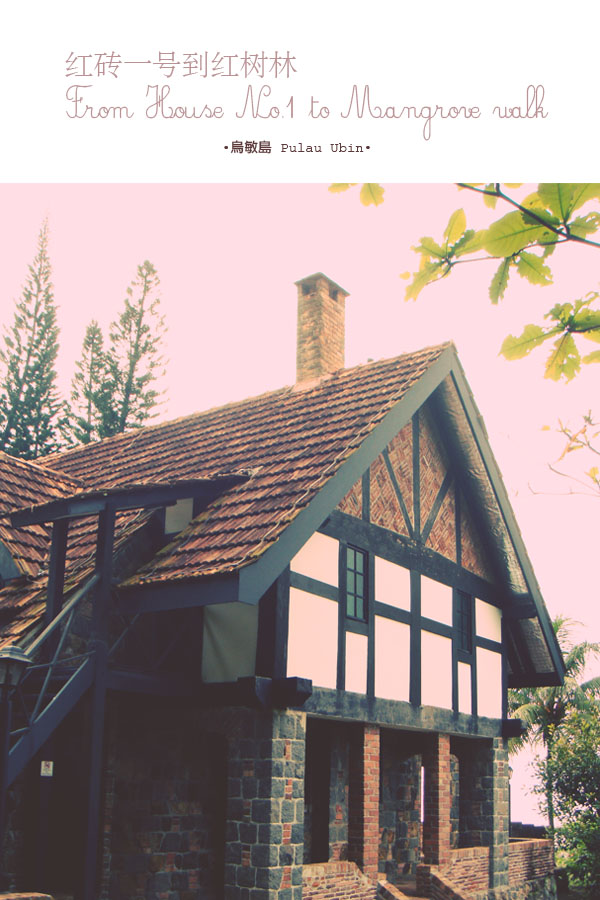Ubin Adventure Part 3-From House No.1 to Mangrove walk


▲ PAGE 2
Top, bottom (left)
House No.1,
This colonial house was originally built in the 1930's for the resident British medical officer. After few decades, it was restored and became the Chek Jawa Visitor Center to serve the public.
• Source from: Wild Singapore

▲ PAGE 3
Top, Bottom(left 1)
House No 1 It has its own jetty and a superior location that facing directly at Pulau Sekudu (Frog Island) and mainland Singapore.
Legend has it that three animals from Singapore - a pig, an elephant and a frog - had a challenge to see who could reach the shore of Johor first. Whichever animal failed to reach the shore would be turned into rock. All three creatures had difficulties swimming, and while the frog turned into Pulau Sekudu, both the pig and the elephant turned into a larger island, Pulau Ubin.
• Source from Wiki
(Don’t you agree it’s hard to relate these 3 animals for both islands?)
Top(2nd&3rd from the left )
Only “walking” will be allowed on Chek Jawa broadwalk. Bicycles will need to be left behind. In order to meticulously observe wild life, walking is still a better choice. 8am, after low tide, sea grasses are like a grass carpet on land.

▲ PAGE 4
Top(left,right)
During the walk I developed a game for my self-called “Spot the differences” for any moving objects. Less than 5mins I spotted the 1st marine life, Acromitus sp Jellyfish with fat oral arms.Bell about 10cm in diameter, with fat sausage-like oral arms, several seen in pools
Bottom(left,right)
2nd Marine life,Tropical silverside. Thousands of little fishes (similar with silver bait fishes – am I right?)
Up to 10cm, but usually 3-6cm long, they are streamlined, torpedo-shaped and with large eyes. Their colours are silvery grey, bluish to bright blue. Usually with a narrow silvery line along the length of the side of the body. In our mangroves, they may school in the hundreds and are sometimes seen leaping out of the water to escape underwater prey.
• Source from Wild Singapore

▲ PAGE 5
Top (left,right)
Knobbly sea stars are not venomous, although they are often brightly coloured and covered with dangerous-looking knobs, nodules and spines. They are also called the Giant Nodulated sea star, Horned sea star or Chocolate Chip sea star.
Top (left,right)
Haddon's carpet anemone
Like other sea anemones, the carpet anemone has stingers in its tentacles. Generally, these stings do not hurt human beings, but they can leave welts on sensitive skin.
• Source from Wild Singapore


▲ PAGE 7
Four-tunate tour
After few times changes, four-tunately we mange to make it to this tour


▲ PAGE 9
Top
According to Wild Singapore, from 12 Dec 07 onwards, it will cost $60 for groups of up to 15 people to engage a tour guide to see Chek Jawa Wetlands' shoreline at close range. I found out about this when I saw a big group of people busy discovering on the wetlands. Yeah! That will be my next adventure.
Bottom(left)
There are few “interesting” signboards that made the four of us very eager to find out what’s hiding underneath that sign, well, I guess I have to come back next time.
Bottom(right)
Totally agreed with that!


▲ PAGE 11
Sea Hibiscus
In general, I pay more attention to flowers than leaves, but after seeing these leaves, I am mesmerized.

▲ PAGE 12
Top(right)
Where is the crab?
Top(left)
Nypa fruticans/Attap Palm/Attap Chee grow in the mangrove; with its outrageous appearance it is almost impossible for me to know that this is one of the essential ingredients for my favorite local dessert - Cendol.
When I was researching on Attap Chee, I was surprised to find out it belonged under the endangered species category.
Bottom(left,right)
Mangrove trees - another endangered species listed. What a sad state we are all in to neglect the sufferings of nature. Mother Earth is losing it precious trees and we all need to play a part to protect them and not cause the endangered species list to lengthen. Let’s all do our part to go green and save these precious commodities we have for our generations to come.

▲ PAGE 13
Top
In years to come, will these trees be still around?
Bottom (1st from the left )
Flying eagle
Bottom (2nd from the left)
Although I am very afraid of heights, I do try my best to reach the highest point of the tower. In the still of the morning, I can feel the whole tower is “shaking”.
Bottom(3rd from the left)
A tree that is as high as Jejawi Tower


▲ PAGE 15
Top
After an 1 hour of strolling, we returned to our starting point
Bottom (1st from the left)
Met the super busy army ants
Bottom (2nd from the left)
A bird can sing melodious tune
Bottom (3rd from the left)
Flemingia strobilifera, is an ingredient in Chinese Medicine studies

Comments
Post a Comment